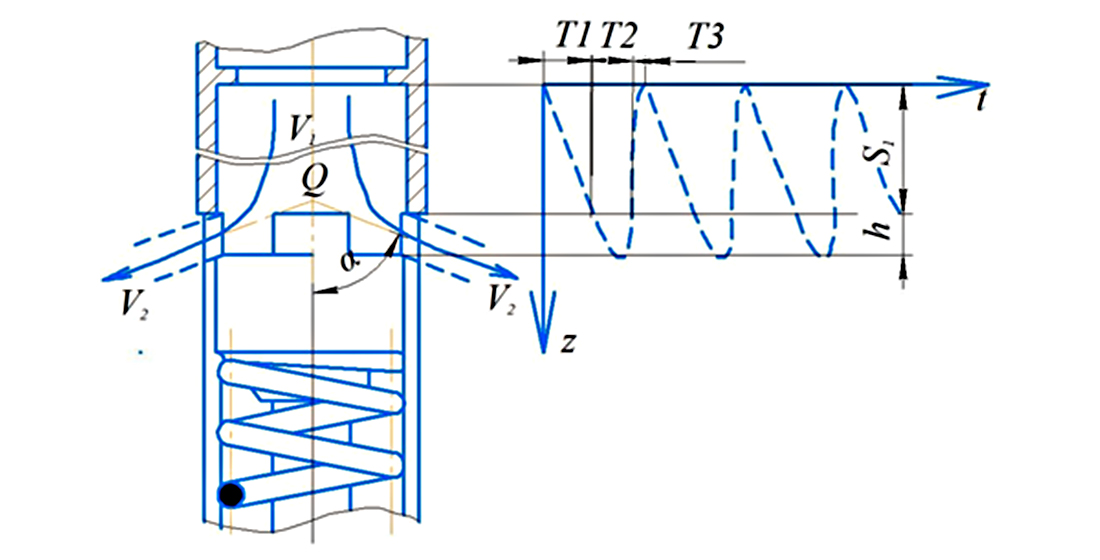Development of a mathematical model of the operation of the swab generator valve
DOI:
https://doi.org/10.15587/2706-5448.2022.265815Keywords:
hydrodynamic well generator, mathematical model, spring deformation, valve opening pressure, spring stiffnessAbstract
The object of research in the work is a mathematical model of the operation of a hydrodynamic well generator of the spring-valve type. The existing problem lies in the fact that vibrating wave swabbing differs from known methods of vibrating wave influence on the near-breakout zone of the formation in its ease of execution and, as a result, a much smaller range of equipment. At the same time, its effectiveness should not be inferior to known methods because the treatment of the formation is carried out by elastic low-frequency pressure fluctuations against the background of depression on the formation. Since the swab generator valve is, in fact, a hydrodynamic well generator (HWG) of the spring-valve type, the processes of pressure fluctuations in the considered devices will be similar. However, because of the review of HWG designs, the presence of a mathematical model describing the operation of rotor-type devices, and not valve type, was revealed. Despite the fact that the mathematical model takes into account all the main factors that determine the process of the HWG piston movement, this model cannot be used to describe the operation process of the swab generator valve. Due to the absence of a pulsating flow created at the wellhead by pumping units. Taking this fact into account, as well as taking into account the compressibility of the liquid passing through the valve, a new mathematical model was developed. It describes both the process of operation of a spring-valve type HWG operating in a well on pump-compressor pipes, and the operation of a swab generator valve that is lowered into a well on a rope. Thanks to this, it is possible to obtain the parameters of the oscillating system: geometric dimensions, inertial mass of moving parts, stiffness of the spring, coefficient of viscous friction between the piston and the valve body, as well as parameters of the working fluid: pressure, flow and its rheological properties. In comparison with the similarly known technology of vibration wave impact on a formation with known HWG, it provides such advantages as a higher speed of movement and frequency of oscillations of the moving end of the spring from the identified essential parameters of the oscillating system and the working fluid of the spring (100–1000 N/mm), consumption of working liquid (10–130 m3/h), valve opening pressure (1–7 MPa). This will make it possible to calculate a helical cylindrical compression spring made of round steel for its operation in the valve of the swab generator without collision of turns.
References
- Akulshyn, O. O., Shtaiden, B. B., Nemyrovska, L. V. (2008). Tekhnolohiia hidroimpulsno-reahentnoho vplyvu dlia stymuliatsii roboty sverdlovyn. Naftova i hazova promyslovist, 3, 36–37.
- Kvietnyi, R. N. (2001). Metody komp’iuternykh obchyslen. Vinnytsia: VDTU, 148.
- Branovytska, S. V., Medvediev, R. B., Fialkov, Yu. Ya. (2004). Obchysliuvalna matematyka ta prohramuvannia. Kyiv: IVTs Vydavnytstvo «Politekhnika», 220.
- Krylyk, L. V., Bohach, I. V., Prokopova, M. O. (2013). Obchysliuvalna matematyka. Interpoliatsiia ta aproksymatsiia tablychnykh danykh. Vinnytsia: VNTU, 111.
- Kolesnytskyi, O. K., Arseniuk, I. R., Mesiura, V. I. (2017). Chyselni metody. Vinnytsia: VNTU, 130.
- Romatschke, P., Romatschke, U. (2019). Relativistic fluid dynamics in and out of equilibrium. Cambridge Monographs on Mathematical Physics. Cambridge University Press. doi: https://doi.org/10.1017/9781108651998
- Gee, R., Hanley, C., Hussain, R., Canuel, L., Martinez, J. (2015). Axial oscillation tools vs. lateral vibration tools for friction reduction – what's the best way to shake the pipe? Proceedings of the SPE/IADC Drilling Conference and Exhibition. Society of Petroleum Engineers. London. doi: https://doi.org/10.2118/173024-ms
- Cheng, X., Meng, B., Han, M., Chen, H., Zhang, H. (2015). A high-efficiency transparent electrification-based generator for harvesting droplet energy. 2015 Transducers-2015 18th International Conference on Solid-State Sensors, Actuators and Microsystems (TRANSDUCERS), 62–65. doi: https://doi.org/10.1109/transducers.2015.7180861
- Li, B. (2014). Development and pilot test of hydro-oscillator. Petroleum Drilling Techniques, 42 (1), 111–113.
- Guan, Z., Zhang, H., Zhang, W., Liu, Y., Liang, D. (2014). Equipment and technique for improving penetration rate by the transformation of drill string vibration to hydraulic pulsating jet. Petroleum Exploration and Development, 41 (5), 678–683. doi: https://doi.org/10.1016/s1876-3804(14)60081-1

Downloads
Published
How to Cite
Issue
Section
License
Copyright (c) 2022 Viktoria Rubel, Vyacheslav Rubel, Jan Ziaja, Roman Yaremiychuk

This work is licensed under a Creative Commons Attribution 4.0 International License.
The consolidation and conditions for the transfer of copyright (identification of authorship) is carried out in the License Agreement. In particular, the authors reserve the right to the authorship of their manuscript and transfer the first publication of this work to the journal under the terms of the Creative Commons CC BY license. At the same time, they have the right to conclude on their own additional agreements concerning the non-exclusive distribution of the work in the form in which it was published by this journal, but provided that the link to the first publication of the article in this journal is preserved.







